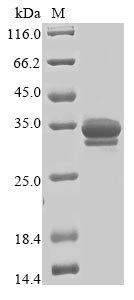The region for expressing recombinant Human TRIM72 contains amino acids 1-269. The calculated molecular weight for this TRIM72 protein is 33.4 kDa. This TRIM72 protein is produced using baculovirus expression system. The TRIM72 gene fragment has been modified by fusing the N-terminal 10xHis tag and C-terminal Myc tag, providing convenience in detecting and purifying the recombinant TRIM72 protein during the following stages.
The human tripartite motif-containing protein 72 (TRIM72), also known as MG53, is a member of the tripartite motif (TRIM) protein family. TRIM72 is predominantly expressed in skeletal and cardiac muscle tissues. It plays a crucial role in membrane repair and maintenance of muscle integrity. TRIM72 is involved in the repair of plasma membrane injuries in response to mechanical stress or damage. It facilitates the resealing of membrane disruptions by interacting with phosphatidylserine exposed to the injured membrane. Additionally, TRIM72 has been implicated in various physiological processes, including muscle regeneration and adaptation to exercise. Understanding TRIM72's functions may have implications for therapeutic strategies targeting muscle-related disorders and injuries.






